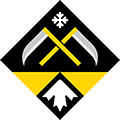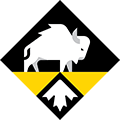BEHIND THE SCENES – MAZDA/KING SNOW SHOOT – PART 2
.jpg)
Precept from BTS Mazda Shoot - Part 1
Temperatures have noticeably dropped since the morning and a new layer of fresh snow has now covered the in-run. Clouds filled the sky making the light flat (merging a contrasting image of colours into one like a blanket of white) before me. I drop making my way down the in-run of the jump, as my edges disrupt the fresh layer of snow below me. I tuck for speed, taking a more direct line than I have all morning (to account for the fresh layer of snow – knowing this typically slows a rider down). I struggle to see the lip of the takeoff. With my depth perception – hindered - I couldn’t tell if I was going too fast or too slow but something didn’t feel right as I approached the jump.
Transitioning to Part 2!
At this moment in time I was halfway up the takeoff without the ability to stop in time before launching off the wedge. I was in the no turning back zone. I was committed. Far from ideal. Once my board left the lip of the jump I am reminded – to my demise - of where I needed to land without having the momentum to get there. The previous jokes from Chris speaking to the harshness of the knuckle (the apex of the snow where the landing meets the deck), “just make sure you make the landing” are now an imminent reality. With my dreams of having a smooth landing crushed, I prepare for impact in noodle like fashion – letting my muscles go loose to let my joints absorb as much of the impact. I call this “Noodle Mode” and if you ask me I’d say it’s a trained skill from many years of harsh landings and knowing this strategy can often lead to a more forgiving one. I flop on the unforgiving flat surface under my feet, knees buckling, bouncing upwards for flight numero 2 and down the landing. Although it probably looked like a wild and painful somersault ride, I was fortunately unscathed.

It’s a funny thing to curse at snow when your sport relies solely on it. A metaphoric double edged sword that you want there to be ample amounts of snow available previous to the course build but too much snow during competition often leads to slower speeds and poor visibility when you need to perform. It doesn’t take much for fresh snow at -25 degrees (and lower) to crystalize into micro snowflakes, creating what sounds like Styrofoam beneath your board with an added resistance to slow things down.
Falls are the not-so-fun part of snowboarding but an important element to one’s progression. It’s a marker for progression usually indicating one’s limits are being pushed and subsequently can lead to progressive breakthroughs – like landing a new trick for the first time. I on the other hand, was not on any progression breakthrough. Just an office guy – moving from the chair to the air – allowing me to revisit what felt like my competition days, yet only attempting the same trick I did hours earlier.
A little shaken up but ligaments intact, I decide to call it for the day to conserve energy for filming the next day. This run, although not going as planned, served as the ultimate way to develop trust with the GoPro Grill Mount (a mouth guard with an arm extension to mount a GoPro camera at the end of it). In all honesty I was reluctant to use the GoPro Grill Mount for my preconceived notion of the discomfort that a camera mounted millimeters away from my mouth would have but this experience was enough for me to gain a level of trust with the device.
With speed being a concern and a variable to potentially impact the success rate of shots for the next few days knowing temperatures were to drop to a targeted -34 and colder I decided to motor to Banff and have my board tuned up. When the temperatures fall below -25 degrees I learned that most waxing irons, even one with the name - Iron Maiden, won’t achieve temperatures high enough to even melt the wax suited for these frigid temperatures and therefore won’t allow the wax to properly seep into the core of a snowboard. With the help of a high temp roller machine at the Tune Shop this cold wax paired with a base grind structure should speed things up. The structure creates channels or grooves on the board’s base at 45 degree angles overlapping in the shape of a ‘X’ along the lengthwise axis from nose to tail. The angled design allows water and snow particles to move through the board quicker requiring a fraction of the surface area compared to the factory channels running lengthwise from nose to tail (parallel to the edges) of a snowboard. An added benefit of this design is that it still works universally whether the rider is riding switch or regular stance. Little did I know – at this moment in time – this was key and integral to the success of a shot that was fully derailed from the original plan in the days following.

The next morning was the first of the film days – temperatures have dipped down to a bone chilling – 34 degrees and an extreme weather warning has been stated across Environment Canada for the Rockies.
We gather with the crew in the morning and discuss an overview of the plan to film on-hill scenes beginning with the scenes at the top of the mountain and work our way down the course as we do. This meant getting both Mazda3’s up to the top. After gearing up I was approached by one of the Fortress staff asking if I could drive one of the Mazda’s up the mountain. A warm car with heated seats, heated steering wheel, and warm AC?? – sounds good to me. This was a no brainer on the comfort front but honestly I was excited to test drive a car up the same mountain face in which I skied down when I was 10 years old. The only rule was to steer clear from the freshly groomed snow track (slightly wider than a cars width) trailing all the way up to the top as the tillers on the Snowcat make the snow too soft for the weight of a car to drive over and would therefore get stuck. There was of course the looming responsibility of the car’s health and co-pilot/filmer Taylor who joined in as passenger too: thinking I better not f*@k this up. The excitement settled in as I jumped into the driver seat with a steep snow covered hill in front of me - this was going to be fun.
.jpg)
[Photo Courtesy Cam Hilts]
Driving the Mazda3 AWD up a ski-run was nothing short of exhilarating. The sight of passing a snowboard rail on my left as we made our way up the mountain in a car really put the absurdness of this in perspective. After nearly making it all the way up the initial and steepest part of the slope, the car slowed and we started losing momentum, and you could feel the tires starting to dig in deeper as we had more distance to go. I honestly thought we were going to get stuck trying to maintain the little momentum we had. The Mazda3 didn’t want to give up and muscled its way to the top. We had a brief moment of celebration knowing we didn’t have to call in the snowcat quite yet to pull us out and we were able to continue our voyage to the top.
.jpg)
[Photo Courtesy Cam Hilts]
It was really insane to see how everyone involved in the production continued to work seamlessly with no shortage of work ethic or desire despite being tested physically and mentally in the cold. Beards froze, drones froze, camera parts broke, movi motors stopped working, and avoiding frost bite was a legitimate concern. Brief moments of expression and humour from the crew was the dopamine hit to keep motivation levels high in the same way we relied on snacks (like a good ol Dad’s cookie) to maintain blood sugar levels.
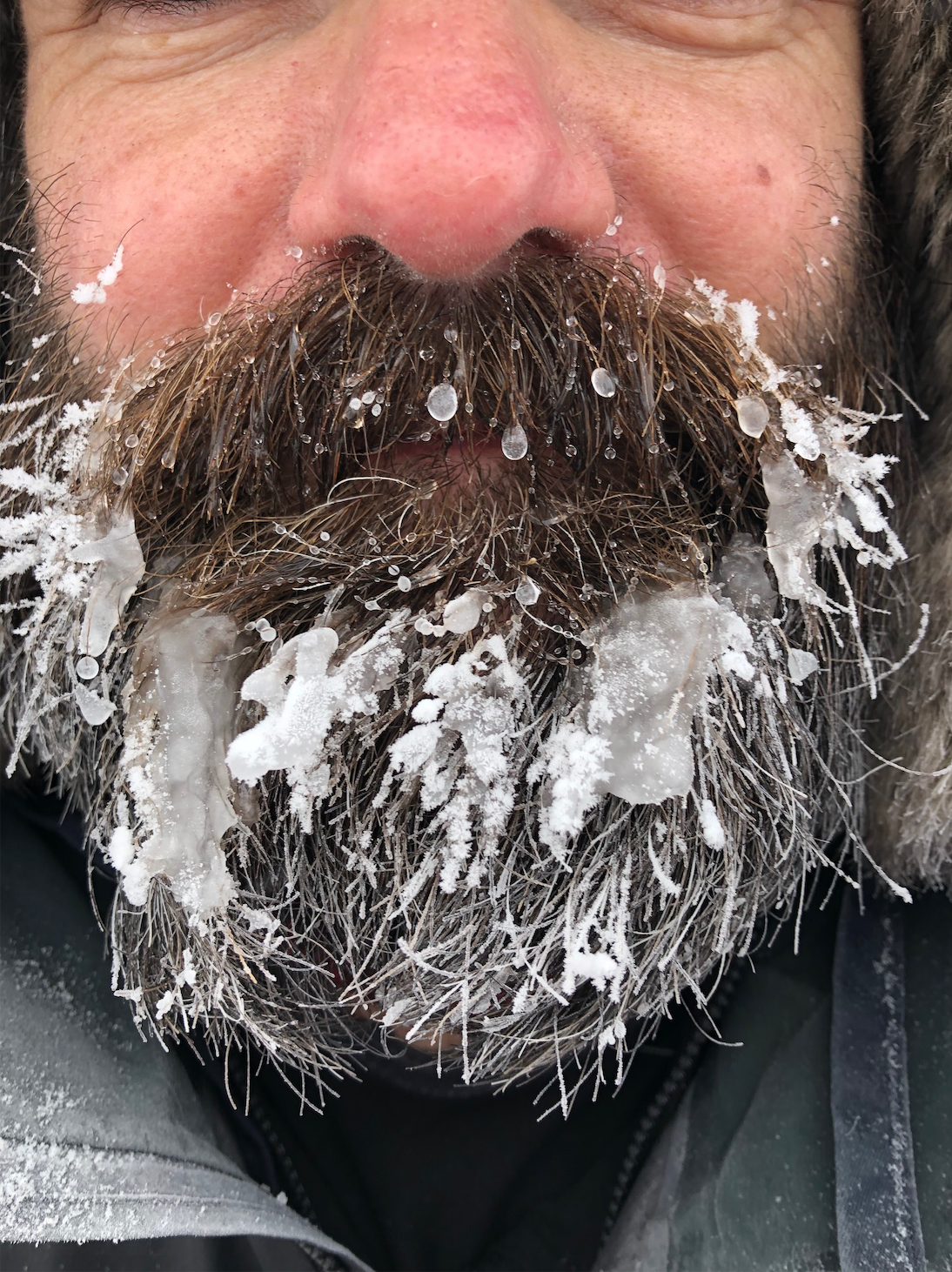
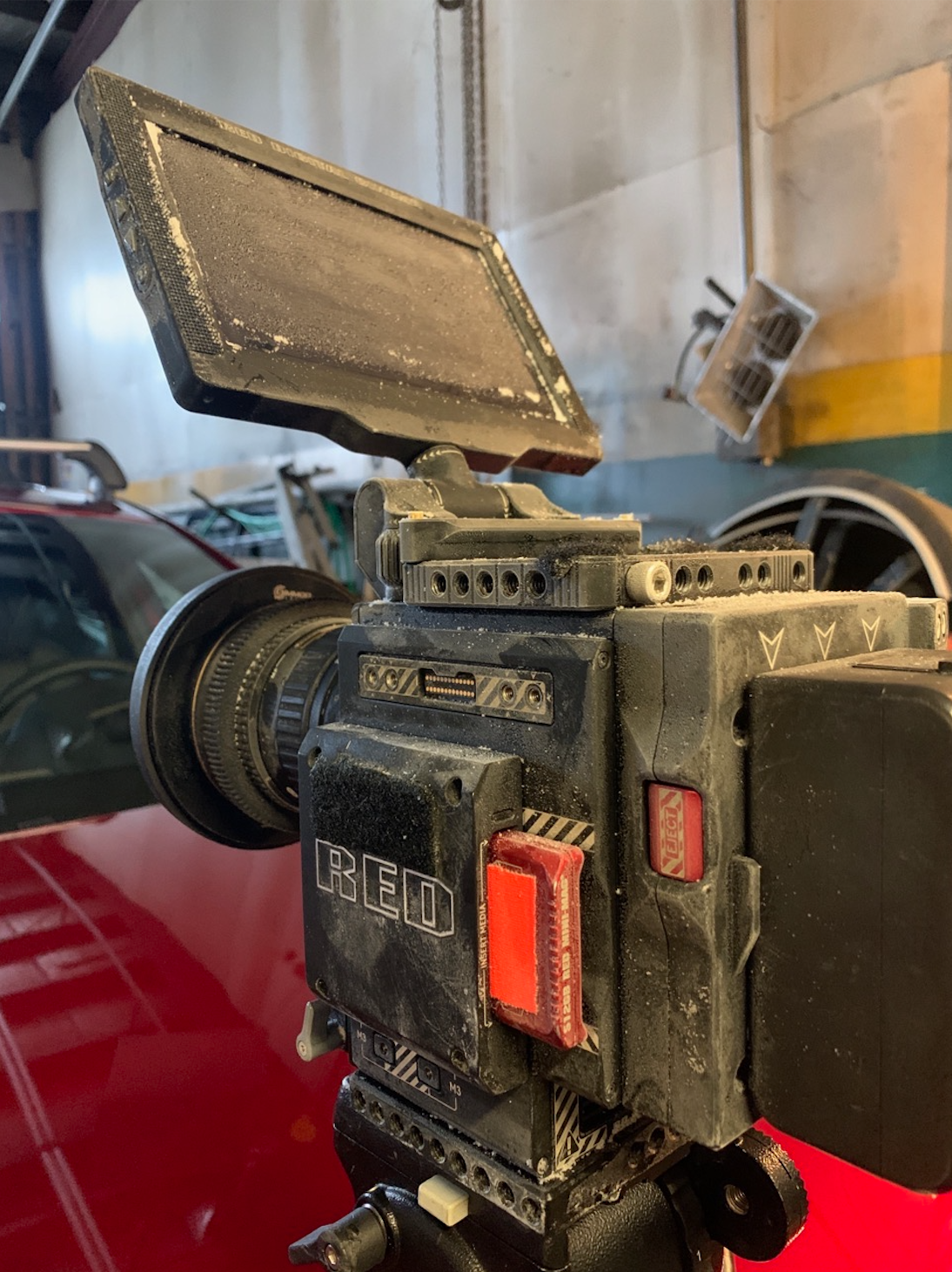
There’s a degree of acting that goes into some of the less snowboard intensive shots and quite frankly something as simple as a hand wave, fist bump, and smile on camera is not easy to do on demand. When other factors such as extreme cold settle in while you wait for your cue to perform does not contribute to the level of enthusiasm required.
In one shot that required me to greet the passenger and stunt driver in the Mazda3 at the end of the run led to an instinct I didn’t know I had. After being pulled in behind a sled, snowboarding parallel to the Mazda, I speed checked to the same point where the car stopped (as seen below). Upon engaging with Will in the passenger seat to “chat” share the “stoke” and “excitement” my default was to “bounce” where I would move up and down even though I was meant to remain steady through the shot. This became comical for everyone as I would instinctively default to this without fail almost every time (must be my attempt to stay warm and perhaps to raise my enthusiasm for the celebratory shot). I was never cut out for Hollywood. My instinct to repeatedly “bounce” on-set against the director’s wishes isn’t helping my chances either. Cheers to my acting career. Short and sweet? Let’s keep it that way.
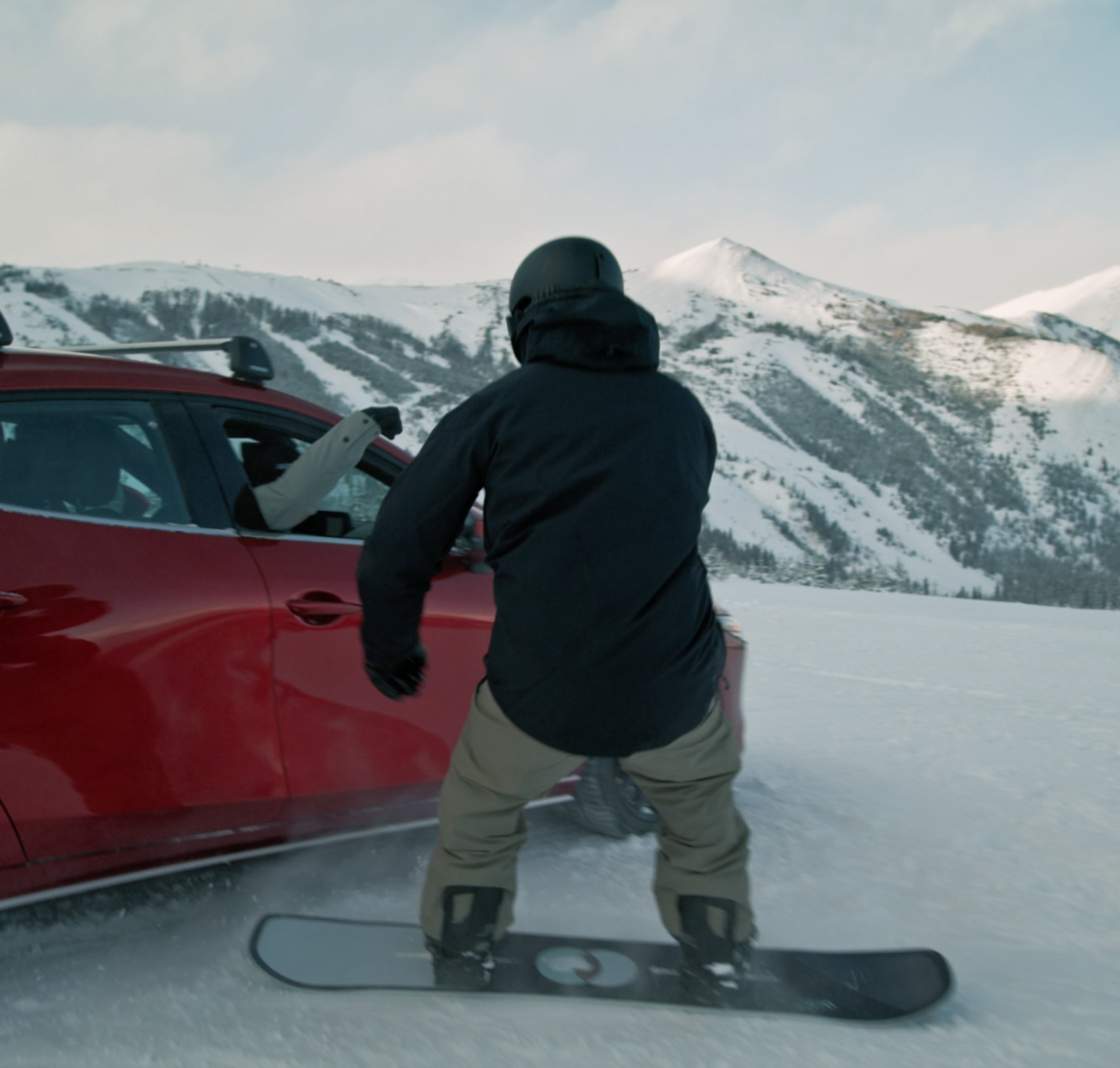
What was surprising to me that the seemingly simple shots like this one often took more takes to achieve than the more trick intensive shots with the exception of the jump shot (more on that later). For example the birds eye view of the drone shot of me performing a rail trick (backside bluntside to fakie) on the rail with the Mazda car driving next to me was achieved on the first take to my surprise. While a shot of me carving my snowboard as seen below required close to 10-12 takes to hammer down. There are so many elements and variables that are considered into each shot from a production standpoint (proper angle, type of lens, lighting, lens focus… to name a few) and the added challenge to execute a toe-side carve in a trajectory arch to land in a destination point that had a buffer zone of an inch on both sides given the tightness of the shot. The simplicity of the trick was not the issue but the timing, speed and precision of everything at play had to align. As for my acting skills – well… let’s not go there.
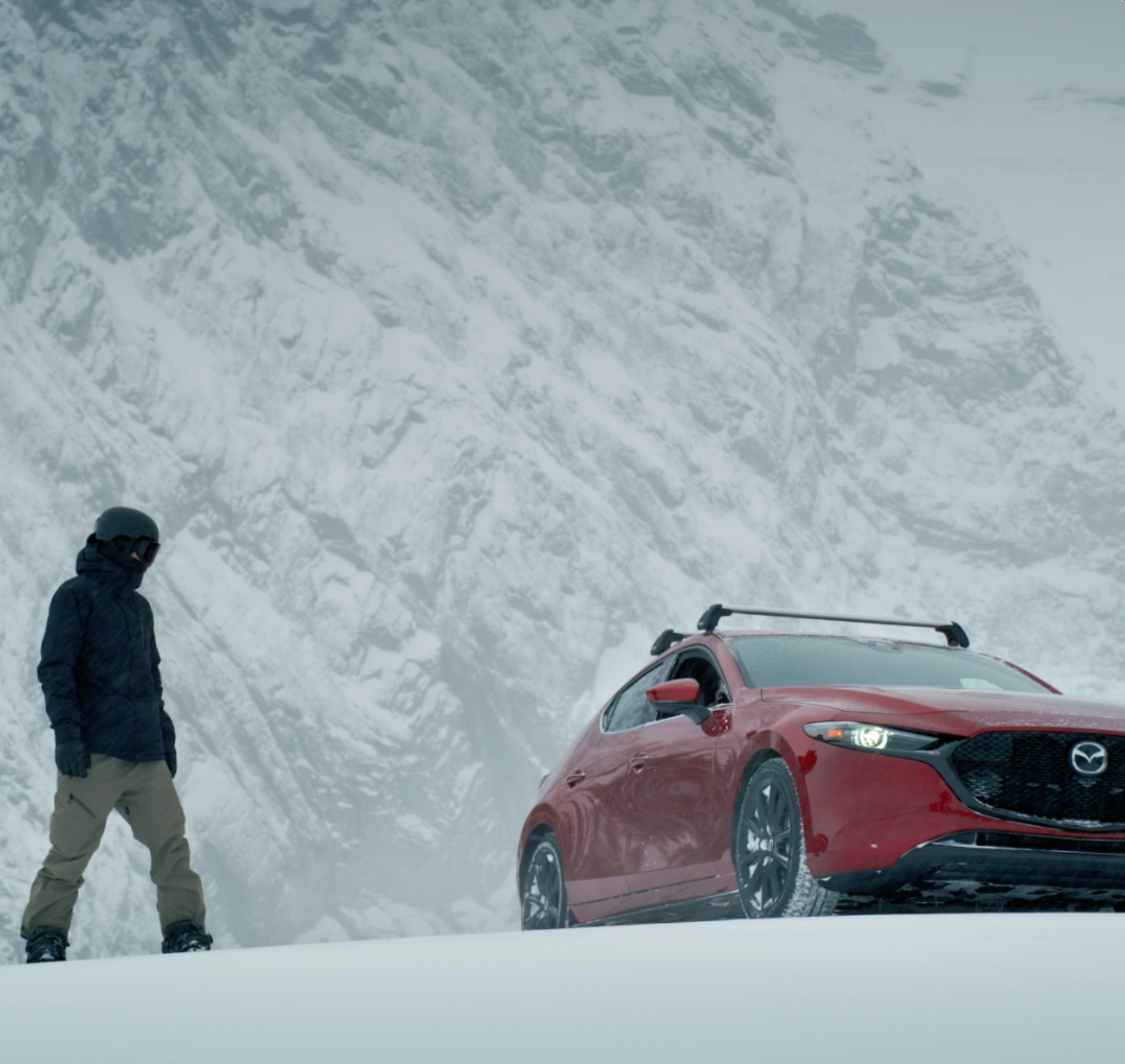
On the last day of the shoot “performance day” I will call it. This was a day of filming the jump scene. Temperatures remained the same - “Cold as” - and I came down with cold sweats the night before. Little did I know I was coming down with the flu but as the demands of riders during a competition don’t shift neither do they on-set. I knew I had to “be on” regardless of how I felt - reminding me of a time when I competed in Ruka, Finland at a World Cup Halfpipe event when cold temperatures made for an extremely icy halfpipe – it was scary and by no means enticing to ride in the daytime darkness.
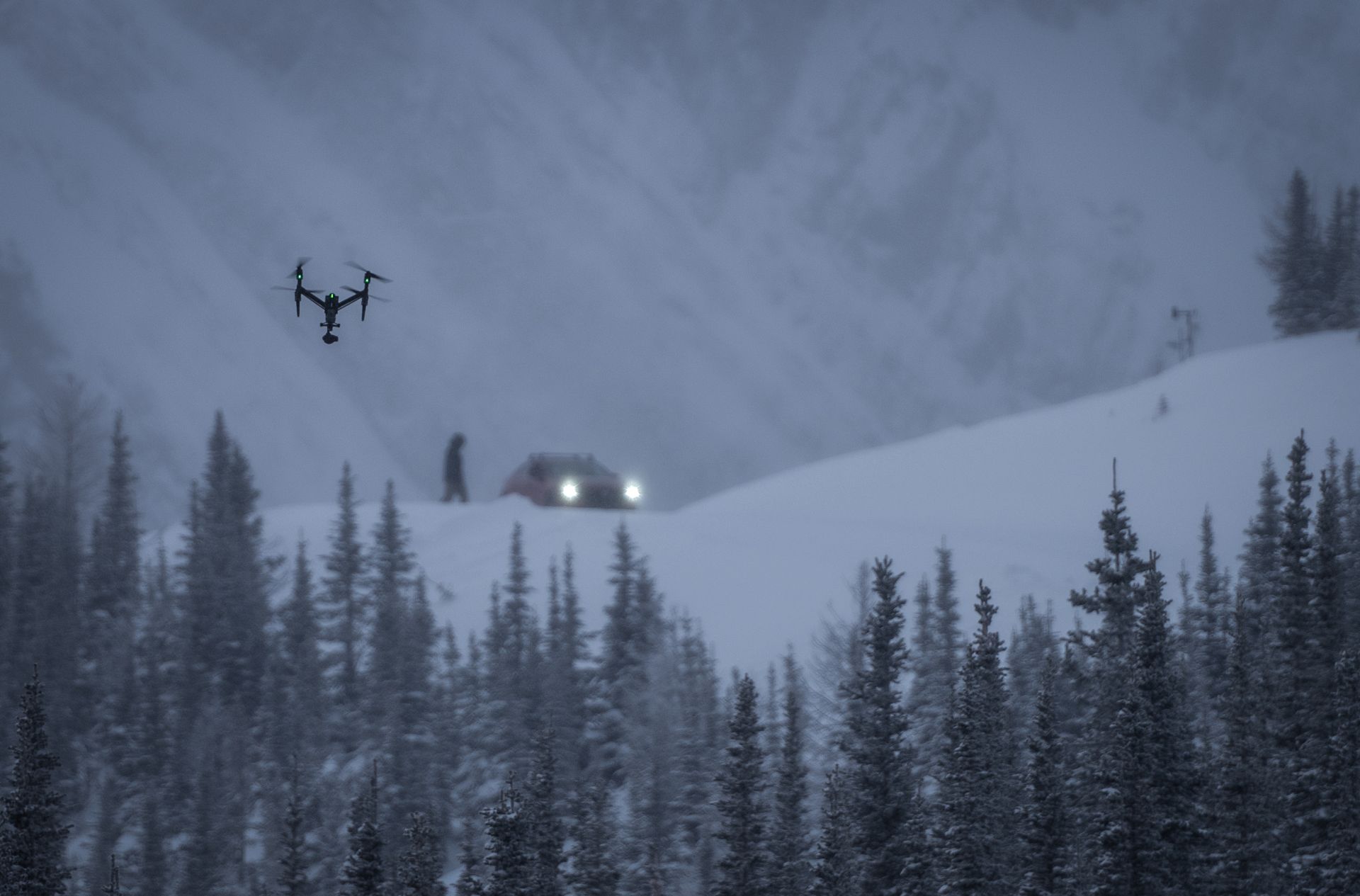
[Photo Courtesy of Alex Chan Media]
We arrive on-site for 6:30am and while the sun was still set to rise I jumped on a snowmobile and headed to the top to start prepping the in-run and takeoff of the jump to remove the fresh snow from the night before. After some raking and slide slipping on the in-run the jump was ready, cameras were rolling, drones were flying. It was GO TIME! I dial in the speed, with my board now running a little faster thanks to the fresh tune, and after several takes on the first of 3 jump angles – video pan across the jump takeoff - we move on to the more challenging shot – GoPro POV shot.
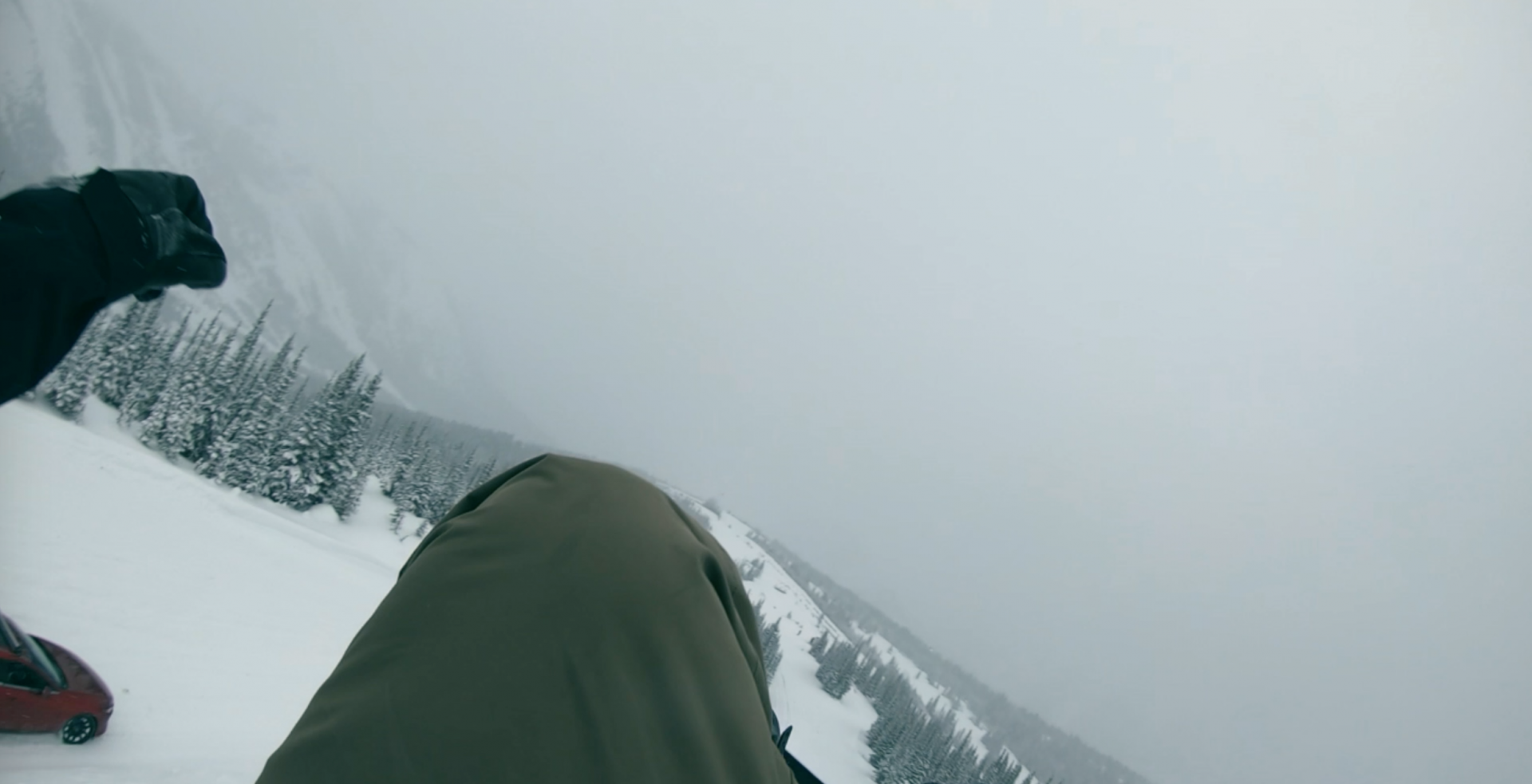

This shot in particular had a lot of variables at play as the GoPro camera (being held in by a mouth mount) needed to catch a precise moment in time aligning the grab, rotation - mid air - at the apex of the jump with the Mazda in frame as it was being driven down the mountain. Timing between the speed of the Mazda and myself was key so was the angle of the GoPro mount dangling from my mouth as was the execution of the axis I spun on. With so many variables at play combined with my own battle to put my landing gear down resulted in over 15 takes and many backseat slams. I could not seem to land the backside 720 for the life of me which was problematic as its key to the shot list. I’m now running on a reserve mustering the little bit of energy I have left. After a pinnacle pep talk with Crispin I had to let go of my stubbornness to land the Backside 720 with each subsequent fall rendering less energy and more pain than before. We rethought the strategy and agreed to improvise with a Cab 540 as this would still achieve the optics of the landed shot they would need. I was reluctant to deviate from the plan as it would make it seem like I’m preforming a trick in its entirety when this is not true. Historically this would be largely frowned upon in any snowboard movie for riders caught doing this. Regardless I did not have much energy or physical capacity to withstand more falls. At this point I was limping and my left ankle starting to swell, knee and tailbone starting to ach. I hopped on the sled and set my stubbornness aside committing to the jump, switch. I performed the Cab 540 and landed. I could hear the excitement of the film crew cheer as this shot was victorious for everyone involved – sorry it took so damn long.
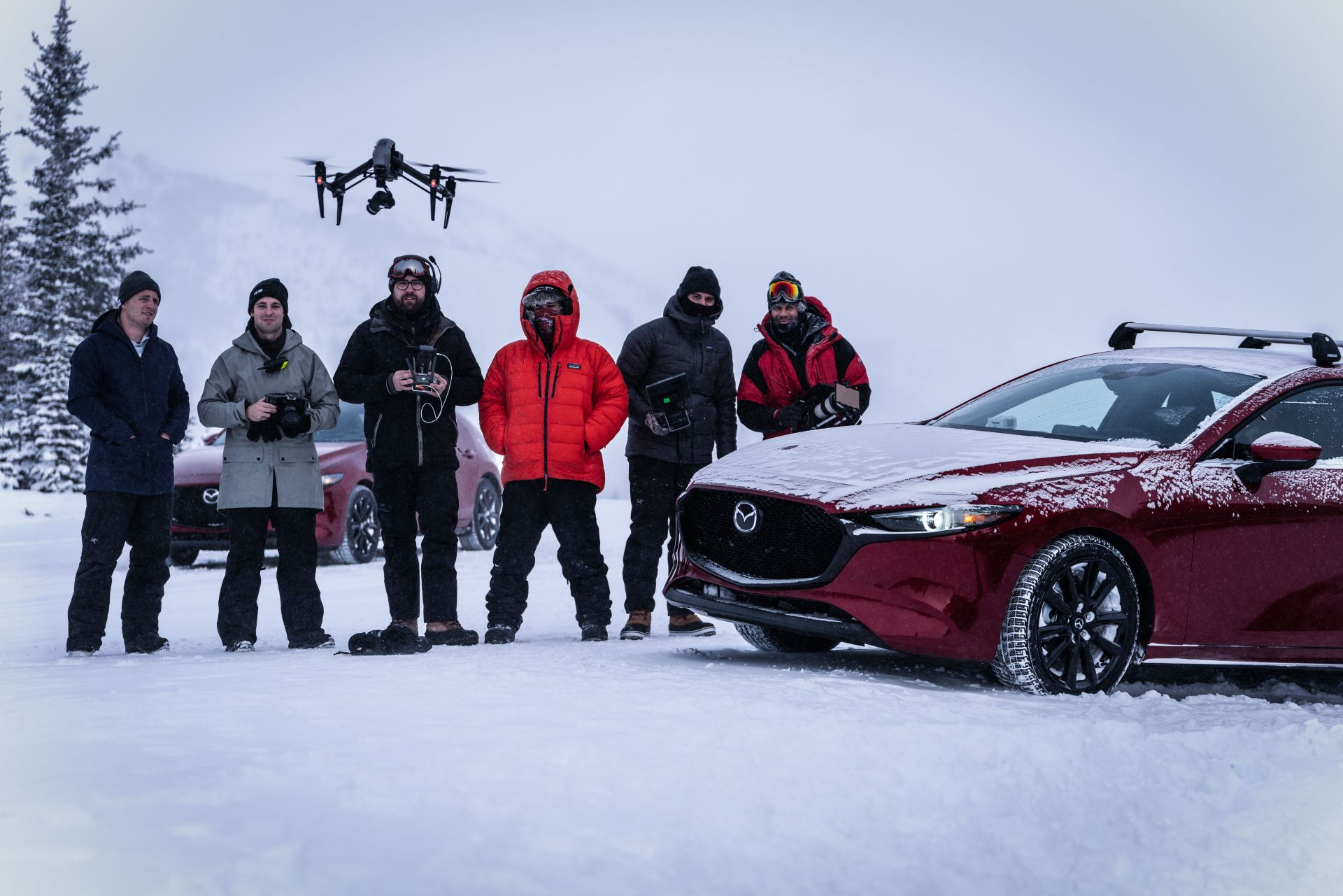 [L>R: Brennan (Stunt Driver), Cam (Talent Coordinator), Patrick (Topo Films - Executive Producer), Taylor (Production Assistant), Jordie (Topo Films - Executive Director), Jay (Production Assistant)] // Photo Cred: Alex Chan Media
[L>R: Brennan (Stunt Driver), Cam (Talent Coordinator), Patrick (Topo Films - Executive Producer), Taylor (Production Assistant), Jordie (Topo Films - Executive Director), Jay (Production Assistant)] // Photo Cred: Alex Chan Media
It was incredible to be part of a crew who shared a mutual tenacity and desire to achieve the vision for this project. Everyone involved was exposed to the frigid temperatures no doubt likely experiencing their own personal battles being pushed mentally and physically for the inconvenience that it was. No one complained and ambitious spirits prevailed. This was epic. Looking back at it now it was quite the saga.
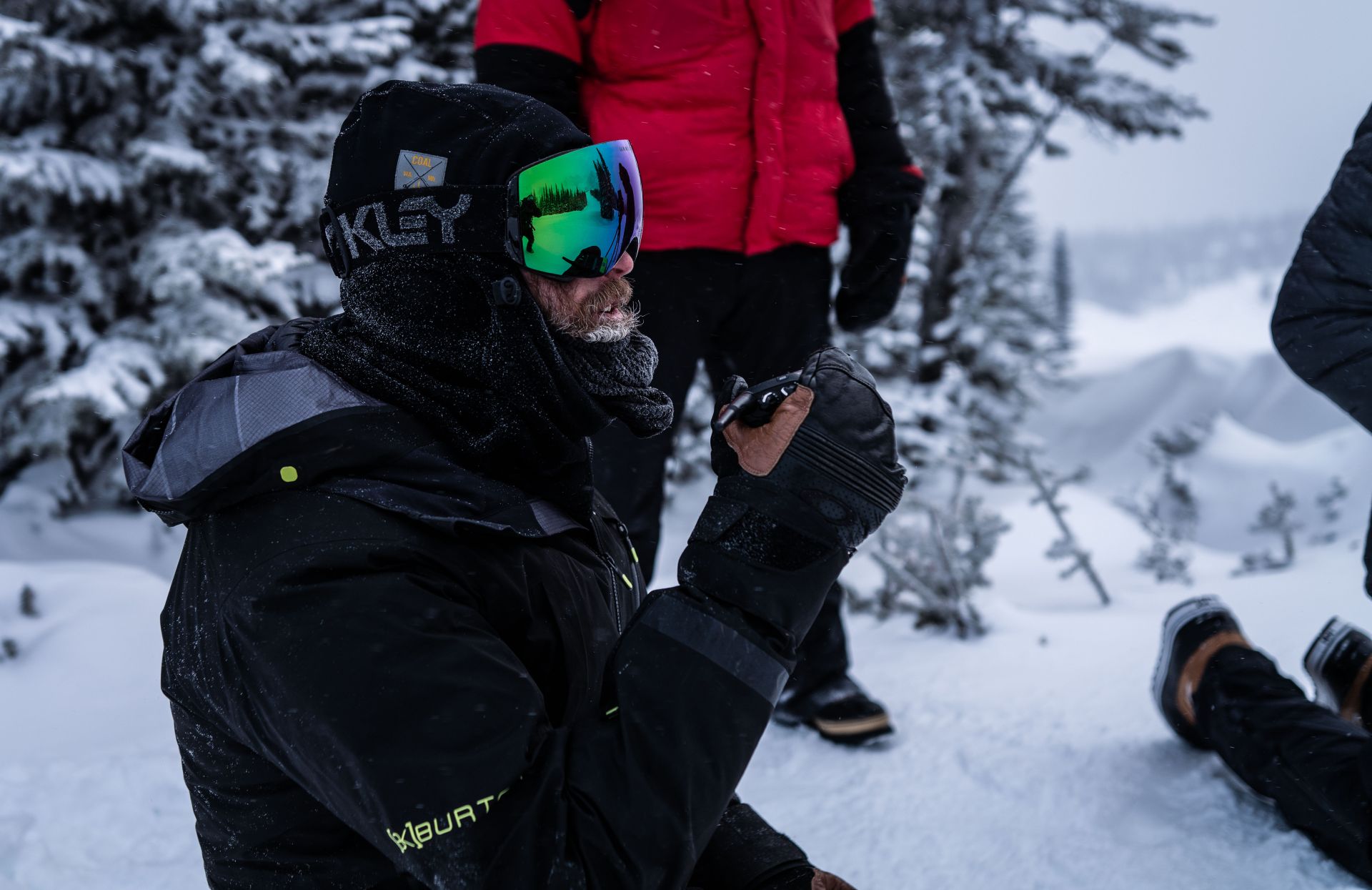
[Crispin Cannon - Art Director/King Snow] // Photo Courtesy of Alex Chan Media
Thanks to Crispin for his leadership through this. Your ability to reframe perspective was key to my success in this. Special thank you to the staff at Fortress Mountain for making this all possible and being so accommodating through it all - being handed electric heated socks was pretty sweet. Shout outs to all the staff at King Snow, TOPO Films and Mazda Canada for their relentless efforts and contribution in the making of this project.
Article by: Kyle Thomas





